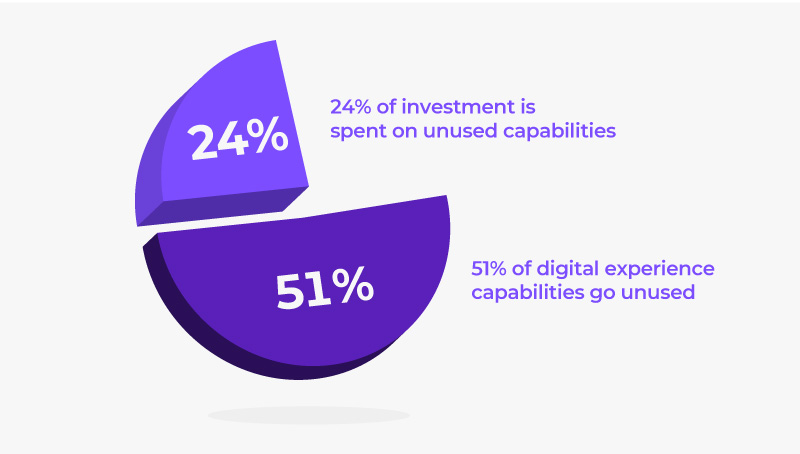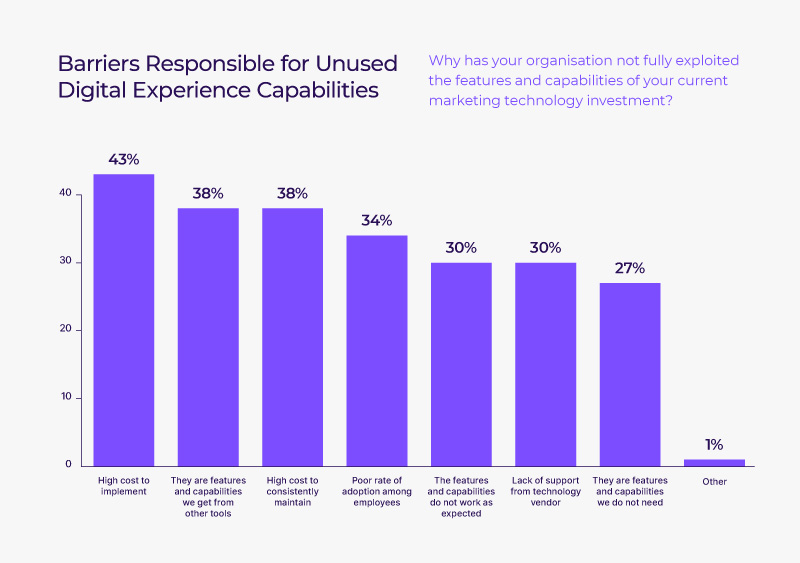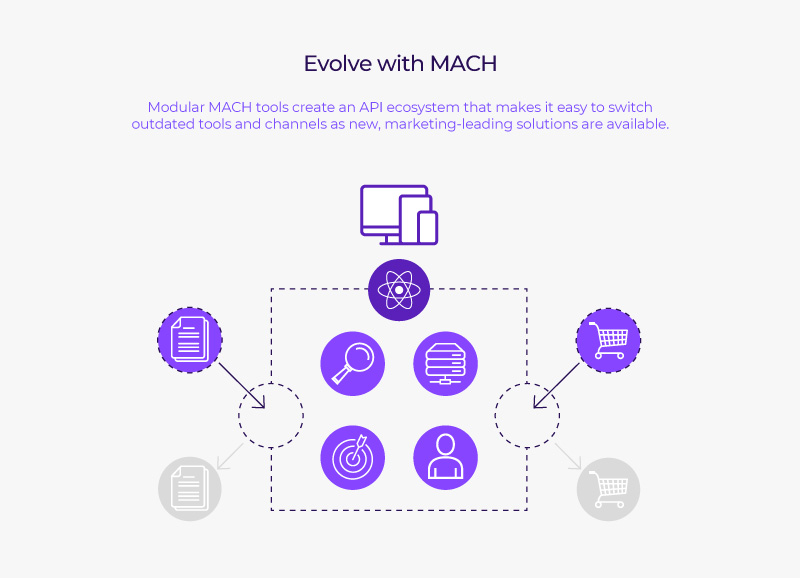Why 51% of Digital Experience Capabilities Sit on the Shelf

Enterprise companies only use half of the capabilities of the digital experience technologies they invest in, according to our recent survey of 100 business, technology, and marketing leaders in UK enterprises. Those features aren’t just taking up space, but significant costs. Respondents estimate that, on average, maintaining and licensing these unused features accounts for 24% of their current digital experience investment.

While our study focused on businesses in the United Kingdom, unused software is hardly a regional issue. A 2016 study estimates that there is $259 worth of unnecessary, unwanted software on each computer in every office worldwide.
Features aren’t going unused because of a lack of need. Over half of our survey respondents (52%) said that they expected substantial investment in new technologies to meet their digital transformation ambitions in the next 18 months. Worldwide spending on digital transformation is expected to reach $2.3 Trillion in 2023; if companies are allocating a quarter to unused features, that means billions of dollars on unused capabilities.
While we were surprised to learn that such a large percentage of digital experience investment was wasted, we did expect that very few companies were exploiting their full technology stack. We were more curious about why these tools aren’t implemented and how companies evaluate new tools to prevent unused investment.
Today’s Roadblock: Expensive Implementation
The high cost of implementation was the most significant pain point, with 43% of respondents listing it as a barrier responsible for unused digital experience capabilities.
For many companies, a rapid transformation has led to a web of custom integrations made on an as-needed basis. Implementing new technology doesn’t just mean wiring it into the system, but detangling the spaghetti of integrations currently there. A tedious process at best, and in some cases, it turns into a scavenger hunt for information on connectors built by someone no longer at the company.
Tellingly, 58% of the respondents (and 74% of technology decision-makers) said that a lack of integration ability was a top reason their current investment would become inadequate over the next 18 months.
The integration headache doesn’t just slow down transformation, it can stop it. In an interview about the company’s decision to modernize its architecture, The Spectator’s Director of Digital said, “In terms of ability to innovate, everything had a cost associated with it, which put us off doing anything risky. That meant our technology was stagnating — and so was our ability to serve customers.”
If stitching a new technology into the stack is the largest barrier today, when application integrations rates are just 31% in the US and 26% in the UK, companies aiming for a more connected experience need an integration makeover — or risk getting locked into a legacy knot of dependencies.
Tomorrow’s Road: Composable Architecture
While it would be great to stop time and tidy up your toolkit all at once, businesses don’t have that luxury.
“Companies are modernizing their approach to digital in stages.” explains Neha Sampat, CEO of Contenstack, “They need to be able to access new technologies and tools now while transitioning their stack over time. Modern software needs to integrate not only with other new technologies but also with legacy tools to make the wider digital transformation as smooth as possible.”
An increasing amount of software providers are coming around to this way of thinking. The digital experience is now too extensive for any one platform to handle, and modern vendors understand that the most competitive tools are the ones that excel in their specific area — and play nicely with everyone else.
Recently launched, the MACH Alliance is a growing group of enterprise vendors and system integrators that believe this type of composable architecture will power the next generation of business and technology. With Microservices-based, API-first, Cloud-native, and Headless solutions, the Alliance is helping enterprises embrace the paradigm shift from legacy platforms to an open technology ecosystem that’s designed to evolve.

Today’s Roadblock: Feature Bloat
Feature overlap between tools was said to be a reason for unused investment by 38% of respondents. These companies may have started on a one-size-fits-all software suite for their digital experience, but as their ambitions became more unique, they turned to more modern tools.
For instance, a company’s main site might run on the legacy platform. However, a headless commerce system handles transactions, another vendor optimizes on-site search, and there’s a custom-built solution for the mobile experience. Because the original vendor suite was designed to be a “one-stop-shop” for digital, adding a new tool often requires custom workarounds to integrate — making the original platform very sticky. A critical part of the business may depend on only 10% of the legacy platform, but the licensing fee still requires payment for 100% of the suite.
Business, technology, and marketing decision-makers felt similarly about feature overlap, with 35%, 41%, and 36%, respectively, listing it as a barrier. However, they differed when it came to feature necessity. Technology leaders ranked “they are features and capabilities we do not need” as the most common barrier (44%) while business and marketing both ranked it as the lowest (19% and 15%, respectively). Hinting at a disconnect between the groups in regards to digital ambition and technology capabilities.
Overall, whether due to duplicate features or unnecessary capabilities, it’s clear that many enterprise businesses are finding their modern ambitions are stuck on legacy feature management practices.
Tomorrow’s Road: Modular Tools
As mentioned above, enterprise technology is moving away from the classic, single-vendor suite to a modular solution ecosystem. In a recent interview with Matthew Baier, MACH Alliance board member, he spoke about the freedom offered by composable tools:
“MACH is as revolutionary as the “undo” button. You can make decisions that don’t punish you for years to come. You can pick a piece of technology that you’re unsure about, and instead of committing to it for the next ten years, you can test it out. If it works as expected, it’s already there and integrated. And if it doesn’t, you can remove it from the stack without everything falling apart.”

Technology is one half of the equation for useful features; the other is market awareness. When discussing the best ways to evaluate new technologies, the Director of Digital of an iconic British luxury fashion house advised:
“The best question you can ever ask in an evaluation is if they can give you a specific example of where they deployed something recently that came from a customer idea. For the platforms we chose, within seconds, a person in the room could tell us one or two very good recent features they built because a customer suggested it. That is really authentic insight showing that they are listening to and partnering with their customers.”
Selecting modular tools with customer-driven feature development helps businesses quickly access the capabilities they need and quickly remove the ones they don’t.
Today’s Roadblock: Maintenance Burden
The high cost of consistently maintaining capabilities was listed by 38% of respondents as a barrier to use, and 36% said that the time spent maintaining their current digital experience investment is disproportionate to its business value.
According to Devada’s “2019 State of the Developer Report,” 66% of developers find that maintenance of legacy systems and technical debt hinders productivity. So it’s no surprise that 64% of businesses list the need to upgrade outdated infrastructure as the top reason for increasing their IT budgets in 2020.
Of course, maintenance is not only a burden on the backend. Both business and marketing decision-makers were more likely to list maintenance as a barrier than their technology counterparts (45%, 36%, 32%, respectively).
The sales promise of a “data-driven” experience can, in specific platform promotions, conveniently leave out that delivering on that promise requires the user to enter and update massive amounts of data manually. On average, an employee uses eight SaaS applications to do their job, and companies with over 1000+ employees have over 200 SaaS applications in their stack. If these platforms don’t automatically sync, the time required to copy data between them means it’s simply not feasible to keep them all up to date. This means that many data-centric features, such as personalization and analytics capabilities, remain unused.
Tomorrow’s Road: (Really) Try Before You Buy
If a software vendor claims to have a flexible solution that helps businesses move quickly, it should be no problem for enterprises to take a test run of the software beyond the standard sales demo.
“I always recommend to any other company going on this journey to hack your way past the sales deck.” says the Director of Digital at a British luxury fashion house, “There were three key selection decisions that were thrown completely on their head by doing a small, one-day hackathon. We were able to evaluate bottom-up, with facts and evidence, on business cases signed off on by the CIOs. Effectively, decisions were changed because we spent that little bit of time proving things worked.”
These real-world trial runs shouldn’t be limited to developers. Having cross-departmental teams evaluate solutions means that red flags are identified early on in the selection process. Unifying on core selection criteria from the start can help teams agree on mini compromises along the way and prevent anyone from getting locked into effort-heavy tools they never had the chance to veto.
Pave the Way Now for Continued Digital Acceleration
Companies have felt the pressure to transform for quite some time. In 2020 the digital experience is being forced to change even faster. It’s estimated that complex business challenges companies are facing due to Covid-19 has accelerated companies’ digital communication strategy by a global average of 6 years.
Only 27% of our survey respondents felt that their current technology could adequately support their digital transformation ambitions over the next 18 months. One in ten believe that their existing tools are an obstacle to their goals.
With ambitious transformation goals and urgent digital needs, many companies are renovating and expanding their architecture. These improvements can incorporate modern, modular tools to ensure companies unlock themselves from the current barriers of legacy technology and create a solution ecosystem that will be easy to evolve with the enterprise’s digital ambitions.
See the full results of the UK enterprise leader survey: The State of Digital Experience Investment in the United Kingdom
About Contentstack
The Contentstack team comprises highly skilled professionals specializing in product marketing, customer acquisition and retention, and digital marketing strategy. With extensive experience holding senior positions at renowned technology companies across Fortune 500, mid-size, and start-up sectors, our team offers impactful solutions based on diverse backgrounds and extensive industry knowledge.
Contentstack is on a mission to deliver the world’s best digital experiences through a fusion of cutting-edge content management, customer data, personalization, and AI technology. Iconic brands, such as AirFrance KLM, ASICS, Burberry, Mattel, Mitsubishi, and Walmart, depend on the platform to rise above the noise in today's crowded digital markets and gain their competitive edge.
In January 2025, Contentstack proudly secured its first-ever position as a Visionary in the 2025 Gartner® Magic Quadrant™ for Digital Experience Platforms (DXP). Further solidifying its prominent standing, Contentstack was recognized as a Leader in the Forrester Research, Inc. March 2025 report, “The Forrester Wave™: Content Management Systems (CMS), Q1 2025.” Contentstack was the only pure headless provider named as a Leader in the report, which evaluated 13 top CMS providers on 19 criteria for current offering and strategy.
Follow Contentstack on LinkedIn.






.svg?format=pjpg&auto=webp)
.svg?format=pjpg&auto=webp)
.png?format=pjpg&auto=webp)






.png?format=pjpg&auto=webp)
.jpeg)

